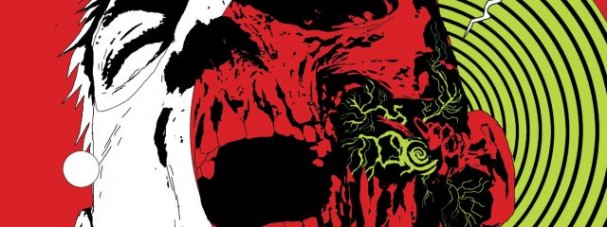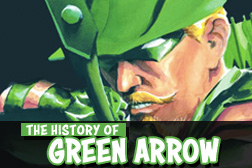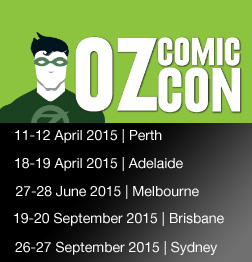Don’t have time for full reviews of comics? Then check out Graphic Bits: bite sized chunks of comic book goodness designed to get behind the panels and into your hearts.
This week (7 August 2013) we get sophomore efforts from Avengers A.I. (Marvel), Hunger (Marvel) and Matt Fraction and Howard Chaykin’s truly brilliant Satellite Sam (Image Comics). We also check in with the hard travelling heroes Green Arrow (DC Comics) and Green Lantern (DC Comics), and see what Ten Grand (Image Comics) is worth.
This week, we’ve also featured reviews elsewhere on the site for Jeff Lemire’s latest masterpiece, Trillium #1 (Vertigo).
Avengers A.I. #2 – Marvel, Sam Humphries (writer), Andre Araujo, Frank D’Armata (artists). Rating: ★★★★
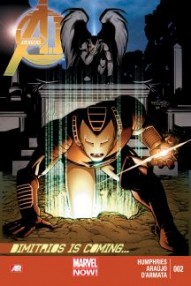 A much-needed dose of adventurous fun coming out of the events of the dour Age of Ultron, Hank Pym’s collective of robots, androids and other artificial intelligence try to trace the origins of new discovery Alexis, and the arrival of a new A.I. going by the name Dimitrios. Humphries uses this issue to quell any doubts as to whether another Avengers title was needed, populating his panels with a fistful of Datas looking for meaning. What we didn’t expect with this title was how much humour would play a part in developing the narrative. Doombot is the comedy smash of 2013’s comic book slate, especially as his recently separated head threatens to return and destroy the Jefferson Memorial in Washington. A perfect example of the fine line he treads between comedy and pathos is in the giant Sentinel that The Vision has given sentience in order to defeat it. His attempts at grasping his predicament would be comical if its ending wasn’t so tragic. Andre Araujo and colorist Frank D’Armata once again bring a pleasing mix of hi-tech and folksy fun, investing their robotic creations with a sense of character missing from some humans in the comic world. If this is an indication of how Marvel will be treating Hank Pym on screen, then there is little doubt that their Ant-Man will be just as successful as their other outings.
A much-needed dose of adventurous fun coming out of the events of the dour Age of Ultron, Hank Pym’s collective of robots, androids and other artificial intelligence try to trace the origins of new discovery Alexis, and the arrival of a new A.I. going by the name Dimitrios. Humphries uses this issue to quell any doubts as to whether another Avengers title was needed, populating his panels with a fistful of Datas looking for meaning. What we didn’t expect with this title was how much humour would play a part in developing the narrative. Doombot is the comedy smash of 2013’s comic book slate, especially as his recently separated head threatens to return and destroy the Jefferson Memorial in Washington. A perfect example of the fine line he treads between comedy and pathos is in the giant Sentinel that The Vision has given sentience in order to defeat it. His attempts at grasping his predicament would be comical if its ending wasn’t so tragic. Andre Araujo and colorist Frank D’Armata once again bring a pleasing mix of hi-tech and folksy fun, investing their robotic creations with a sense of character missing from some humans in the comic world. If this is an indication of how Marvel will be treating Hank Pym on screen, then there is little doubt that their Ant-Man will be just as successful as their other outings.
Green Arrow #23 – DC Comics, Jeff Lemire (writer), Andrea Sorrentino, Marcelo Maiolo (artist). Rating: ★★★★½
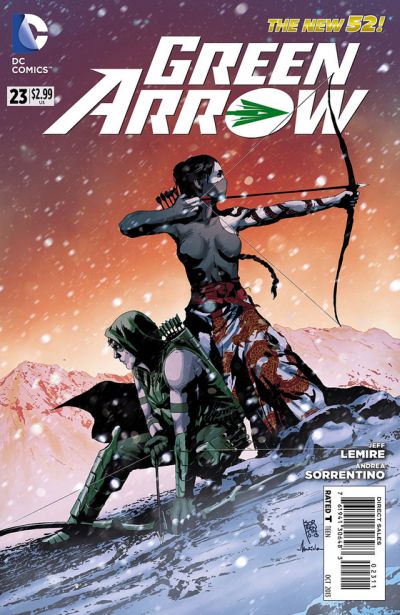 Shado, Count Vertigo and a sense of the mystic? You’d almost think this was classic Green Arrow. In many ways, that’s exactly what Jeff Lemire is striving for in this re-imagining of the Mike Grell era, cracking open the secret origins of Shado and Vertigo and giving both of them a fresh coat of paint for the current DC continuity. Of course, Lemire differs from Grell in one key aspect, and that’s his interweaving of the mythological, the super-powered and the more realistic elements into a single story. For long time readers, it will be like staring into a parallel universe, but one that is stunning to look at. Andre Sorrentino exceeds his own high standards on this issue, and together with colourist Marcelo Maiolo, creates something entire unique to this run. Shado’s flashback tale is told in silhouette on an old parchment in sepia tones, while Ollie’s confrontation with Vertigo spins us out in all the right ways. Lemire gives us a treasure trove of reasons to keep coming back to the book, not least of which is the twist ending, and has provided enough questions in this one issue to last us until the next DC reboot. If you’d given up on previous incarnations of this rebooted title, now is the time to jump back aboard.
Shado, Count Vertigo and a sense of the mystic? You’d almost think this was classic Green Arrow. In many ways, that’s exactly what Jeff Lemire is striving for in this re-imagining of the Mike Grell era, cracking open the secret origins of Shado and Vertigo and giving both of them a fresh coat of paint for the current DC continuity. Of course, Lemire differs from Grell in one key aspect, and that’s his interweaving of the mythological, the super-powered and the more realistic elements into a single story. For long time readers, it will be like staring into a parallel universe, but one that is stunning to look at. Andre Sorrentino exceeds his own high standards on this issue, and together with colourist Marcelo Maiolo, creates something entire unique to this run. Shado’s flashback tale is told in silhouette on an old parchment in sepia tones, while Ollie’s confrontation with Vertigo spins us out in all the right ways. Lemire gives us a treasure trove of reasons to keep coming back to the book, not least of which is the twist ending, and has provided enough questions in this one issue to last us until the next DC reboot. If you’d given up on previous incarnations of this rebooted title, now is the time to jump back aboard.
Green Lantern #23 – DC Comics, Robert Venditti (writer), Billy Tan (artist). Rating: ★★★★
 Robert Venditti begins to carve out his own niche with the third issue in his run. Fuelled by the momentum of Geoff Johns’s final issue, the series hadn’t paused for breath since the new creative team took over. With Hal Jordan feeling every inch of the burden of leadership – with new recruits, a dead corpsman and an escaped prisoner to deal with – we are given the first hints that his will may be faltering. His self-doubt comes out to play in a confrontation with a new Star Sapphire, and it makes Jordan all the more human. There is still plenty of humour to be had, especially as the imposing Kilowog struggles with a tiny chair. Billy Tan comfortably slips into the universe, and after holding back through several pages of dialogue, gets an impressive double-page spread that is up there with the best of Doug Mahnke’s work on the previous run. Now that the series has a clear direction, we get a sense of where this series is headed in the lead-up to the “Lights Out” crossover. Green Lantern #23 conclusively proves that the book has been left in a terrific set of hands. Richard has written a longer piece on this issue for Newsarama.
Robert Venditti begins to carve out his own niche with the third issue in his run. Fuelled by the momentum of Geoff Johns’s final issue, the series hadn’t paused for breath since the new creative team took over. With Hal Jordan feeling every inch of the burden of leadership – with new recruits, a dead corpsman and an escaped prisoner to deal with – we are given the first hints that his will may be faltering. His self-doubt comes out to play in a confrontation with a new Star Sapphire, and it makes Jordan all the more human. There is still plenty of humour to be had, especially as the imposing Kilowog struggles with a tiny chair. Billy Tan comfortably slips into the universe, and after holding back through several pages of dialogue, gets an impressive double-page spread that is up there with the best of Doug Mahnke’s work on the previous run. Now that the series has a clear direction, we get a sense of where this series is headed in the lead-up to the “Lights Out” crossover. Green Lantern #23 conclusively proves that the book has been left in a terrific set of hands. Richard has written a longer piece on this issue for Newsarama.
Hunger #2 – Marvel, Joshua Hale Fialkov (writer), Leonard Kirk, Jesus Aburtov (artists). Rating: ★★★★
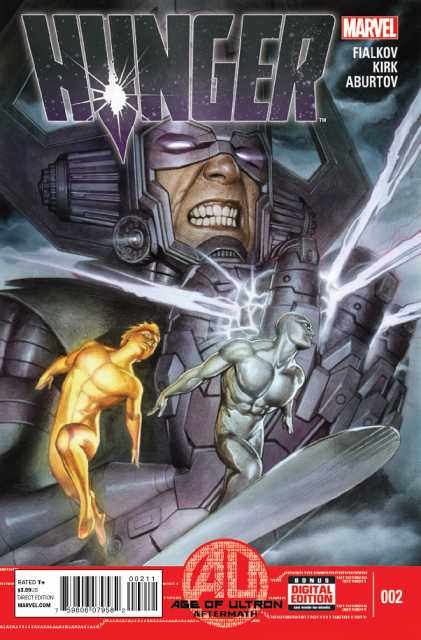 The arrival of Galactus in the Ultimate Marvel Universe would be where most event series end, and that this one has begun that way is one of the many reasons that this mini-series is worth more than a cursory glance. Ultimate Rick Jones teams up with his universe’s Silver Surfer to battle the big hungry purple one, who has super-sized thanks to merging with the robotic swarm Gah Lak Tus. While this may all be leading us directly into another event, and quite possibly spell the end of the Ultimate imprint, we are now halfway through a series where we couldn’t hazard a guess as to what will happen next, especially as Jones is learning that the rift in space and time is a two-way door. Leonard Kirk gives this the epic grandeur it deserves, filling the vastness of space with the best that the cosmic universe has to offer. The revelation of a Marvel multiverse could still mean the end for some long-running titles, but it might also mean that some of those characters get to play in the big leagues as well. For now, we’re willing to just sit back and enjoy the ride.
The arrival of Galactus in the Ultimate Marvel Universe would be where most event series end, and that this one has begun that way is one of the many reasons that this mini-series is worth more than a cursory glance. Ultimate Rick Jones teams up with his universe’s Silver Surfer to battle the big hungry purple one, who has super-sized thanks to merging with the robotic swarm Gah Lak Tus. While this may all be leading us directly into another event, and quite possibly spell the end of the Ultimate imprint, we are now halfway through a series where we couldn’t hazard a guess as to what will happen next, especially as Jones is learning that the rift in space and time is a two-way door. Leonard Kirk gives this the epic grandeur it deserves, filling the vastness of space with the best that the cosmic universe has to offer. The revelation of a Marvel multiverse could still mean the end for some long-running titles, but it might also mean that some of those characters get to play in the big leagues as well. For now, we’re willing to just sit back and enjoy the ride.
Satellite Sam #2 – Image Comics, Matt Fraction (writer), Howard Chaykin (artist). Rating: ★★★★½
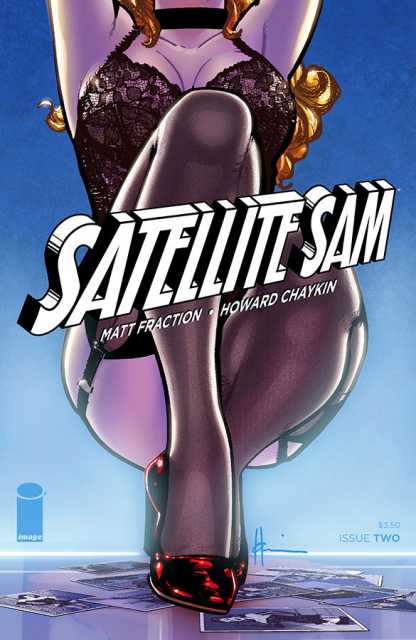 Matt Fraction melts a little bit away from the top of the iceberg, giving us a glimpse at what lies beneath. Desperately trying to hold his fractured family together, a focus on station founder Dr. Joseph Ginsberg dominates this issue, living in fear that Satellite Sam will move out to the West Coast with its star dead. Meanwhile, the star’s son Michael finds his solutions at the bottom of a bottle. Fraction has an ensemble cast, and from this early issue he is demonstrating that he’s unafraid to switch his focus between characters as the story requires it. Chaykin, meanwhile, imbues the players with character, creating a finely detailed world that is both artificial and full of the grit and grime of reality. One could not find a more perfect union of talent coming together for this complex and rewarding tale that treats its audience seriously. The slow boiler looks like it will reward long-term readers, so our advice is to start reading now and hook yourself in for the duration. Richard has written a longer piece on this issue for Newsarama.
Matt Fraction melts a little bit away from the top of the iceberg, giving us a glimpse at what lies beneath. Desperately trying to hold his fractured family together, a focus on station founder Dr. Joseph Ginsberg dominates this issue, living in fear that Satellite Sam will move out to the West Coast with its star dead. Meanwhile, the star’s son Michael finds his solutions at the bottom of a bottle. Fraction has an ensemble cast, and from this early issue he is demonstrating that he’s unafraid to switch his focus between characters as the story requires it. Chaykin, meanwhile, imbues the players with character, creating a finely detailed world that is both artificial and full of the grit and grime of reality. One could not find a more perfect union of talent coming together for this complex and rewarding tale that treats its audience seriously. The slow boiler looks like it will reward long-term readers, so our advice is to start reading now and hook yourself in for the duration. Richard has written a longer piece on this issue for Newsarama.
Ten Grand #4 – Image Comics, J. Michael Straczynski (writer), Ben Templesmith (artist). Rating: ★★★★½
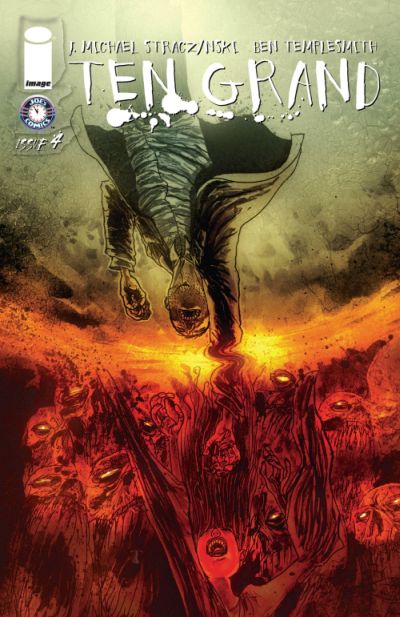 One of the best comics of the year so far, it’s surprising we aren’t hearing more hype being shouted from the rooftops over this one. Another wonderful union of art and narrative, Straczynski raises the stakes for Joe Fitzgerald, hinting that his ability to come back to life from a righteous death may have been taken away. This fourth issue of Ten Grand is mostly exposition, although the real genius of it is that Straczynski lays out the boundaries between heaven, hell and the purgatory that is Earth as an extended action sequence. Comedy and sadness intermingle. The character of Julie, who is a ghost of sorts, will break your heart. Only a few pages later, the entrance to the other side is a billboard for ‘scenic Newark, New Jersey’. Templesmith’s art alone is reason enough to pick up this book, grounding the human world in grit, while highlighting the ethereal in a colour palette that glows and jumps off the page. Fitzergerald narrates that “There are no straight lines leading from our world to hell”, and he could just as easily be talking about Templesmith. A glorious old-school spin on Hellblazer that remains fresh and sinister, and demanding of your full attention.
One of the best comics of the year so far, it’s surprising we aren’t hearing more hype being shouted from the rooftops over this one. Another wonderful union of art and narrative, Straczynski raises the stakes for Joe Fitzgerald, hinting that his ability to come back to life from a righteous death may have been taken away. This fourth issue of Ten Grand is mostly exposition, although the real genius of it is that Straczynski lays out the boundaries between heaven, hell and the purgatory that is Earth as an extended action sequence. Comedy and sadness intermingle. The character of Julie, who is a ghost of sorts, will break your heart. Only a few pages later, the entrance to the other side is a billboard for ‘scenic Newark, New Jersey’. Templesmith’s art alone is reason enough to pick up this book, grounding the human world in grit, while highlighting the ethereal in a colour palette that glows and jumps off the page. Fitzergerald narrates that “There are no straight lines leading from our world to hell”, and he could just as easily be talking about Templesmith. A glorious old-school spin on Hellblazer that remains fresh and sinister, and demanding of your full attention.
Agree or disagree? Got a comment? Start a conversation below, or take it with you on Behind the Panel’s Facebook and Twitter!
If you are an iTunes user, subscribe to our weekly podcast free here and please leave us feedback.

